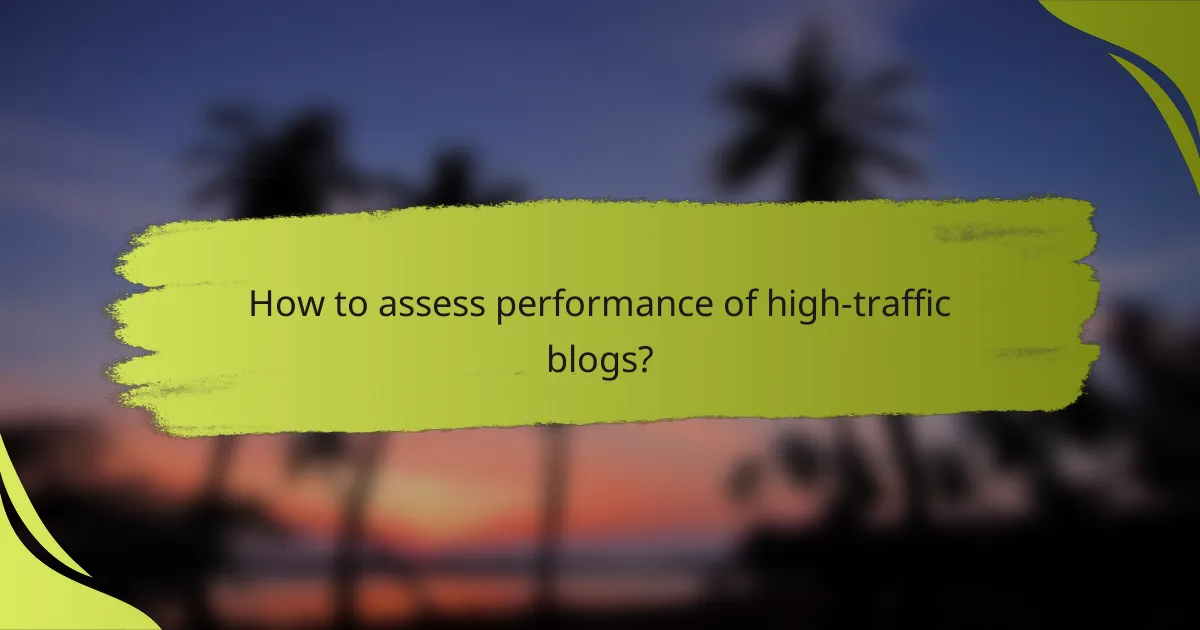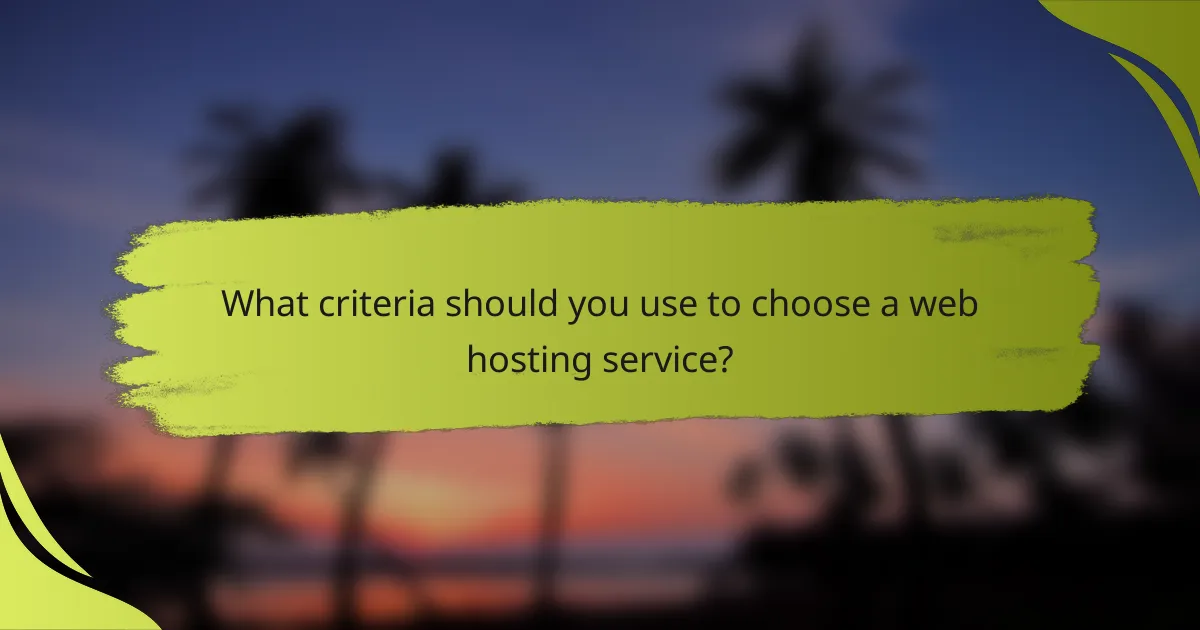Performance assessment of high-traffic blogs is crucial for understanding user interaction and content effectiveness. Key metrics such as traffic analysis, user engagement, and SEO performance play a vital role in maintaining relevance and visibility. While free unlimited web hosting may offer cost savings, it can compromise speed and reliability, ultimately impacting the blog’s success.

How to assess performance of high-traffic blogs?
Assessing the performance of high-traffic blogs involves analyzing various metrics that reflect user interaction, content quality, and overall effectiveness. Key areas to focus on include traffic analysis, user engagement, content evaluation, SEO performance, and monetization strategies.
Traffic analysis tools
Traffic analysis tools provide insights into the number of visitors, page views, and traffic sources for a blog. Popular tools like Google Analytics and SEMrush can help identify trends and patterns in user behavior, allowing bloggers to make informed decisions about content and marketing strategies.
When using these tools, pay attention to metrics such as unique visitors, bounce rate, and average session duration. A high bounce rate may indicate that visitors are not finding what they expect, while a longer session duration suggests engaging content.
User engagement metrics
User engagement metrics measure how visitors interact with a blog’s content. Key indicators include comments, shares, likes, and time spent on pages. High engagement levels often correlate with quality content that resonates with the audience.
To boost engagement, consider adding interactive elements like polls or quizzes. Monitoring these metrics regularly can help identify which topics or formats generate the most interest, guiding future content creation.
Content quality evaluation
Evaluating content quality involves assessing clarity, relevance, and originality. High-quality content should be well-researched, free of errors, and tailored to the target audience’s needs. Regularly updating older posts can also enhance their relevance and performance.
Consider using tools like Grammarly or Hemingway to improve writing quality. Additionally, soliciting feedback from readers can provide valuable insights into how well the content meets their expectations.
SEO performance indicators
SEO performance indicators are crucial for understanding how well a blog ranks in search engine results. Key metrics include organic traffic, keyword rankings, and backlinks. Tools like Moz and Ahrefs can help track these indicators and identify areas for improvement.
To enhance SEO performance, focus on optimizing on-page elements like titles, meta descriptions, and headers. Regularly updating content with relevant keywords can also improve visibility and attract more organic traffic.
Monetization effectiveness
Monetization effectiveness measures how well a blog generates revenue through various channels, such as ads, affiliate marketing, or sponsored content. Tracking metrics like click-through rates and conversion rates can help assess the success of these strategies.
Experimenting with different monetization methods is essential. For instance, affiliate links may perform better in niche markets, while display ads might be more effective for general content. Regularly reviewing performance can help optimize revenue streams.

What are the best practices for high-traffic blogs?
To effectively manage high-traffic blogs, focus on consistent content updates, SEO optimization techniques, and audience targeting strategies. These practices ensure that your blog remains relevant, visible, and engaging to your readers.
Consistent content updates
Regularly updating your blog with fresh content keeps your audience engaged and encourages repeat visits. Aim for a schedule that suits your capacity, whether that’s weekly, bi-weekly, or monthly updates.
Consider creating a content calendar to plan topics in advance and maintain consistency. This approach helps in organizing your posts around seasonal trends or events relevant to your niche.
SEO optimization techniques
Implementing effective SEO strategies is crucial for increasing your blog’s visibility in search engine results. Focus on keyword research, optimizing meta tags, and improving page load speeds to enhance user experience.
Utilize tools like Google Analytics and Search Console to monitor your performance and adjust your strategies based on data insights. Regularly updating older posts with new keywords and information can also boost their rankings.
Audience targeting strategies
Understanding your audience is key to creating content that resonates with them. Use analytics tools to gather demographic data and tailor your content to meet their preferences and interests.
Engage with your readers through comments and social media to gain insights into their needs. Consider segmenting your audience and creating targeted content that addresses specific groups, enhancing relevance and engagement.

How does free unlimited web hosting impact blog performance?
Free unlimited web hosting can significantly affect blog performance, often leading to slower load times and reduced reliability. While it may seem appealing due to no upfront costs, the trade-offs in speed, uptime, and support can hinder a blog’s success.
Speed and uptime considerations
Free hosting services typically have slower speeds compared to paid options, which can lead to longer loading times for your blog. Users may experience delays of several seconds, negatively impacting user experience and search engine rankings.
Uptime is another critical factor; many free hosts do not guarantee consistent availability. It’s common for free services to have uptime rates below 99%, meaning your blog could be inaccessible for hours or even days at a time.
Scalability limitations
Free unlimited web hosting often lacks scalability, making it difficult to accommodate increased traffic. As your blog grows, you may encounter bandwidth restrictions or resource limits that can slow down performance or lead to service interruptions.
When considering future growth, it’s essential to understand that many free hosting providers may not offer easy upgrades to paid plans, forcing you to migrate your blog to a different host, which can be time-consuming and complex.
Support and reliability factors
Support options with free hosting are often minimal or non-existent, leaving you to troubleshoot issues on your own. This can be particularly challenging if you encounter technical problems that affect your blog’s performance.
Reliability is another concern; free hosting services may not have the same level of infrastructure or security as paid providers. This can expose your blog to risks such as data loss or security breaches, which can have long-term consequences for your audience and reputation.

What are the top free unlimited web hosting providers?
The leading free unlimited web hosting providers include InfinityFree, 000webhost, and Freehostia. These platforms offer various features suitable for personal projects or small businesses, allowing users to host websites without incurring costs.
InfinityFree overview
InfinityFree is a popular choice for users seeking free unlimited web hosting. It provides unlimited disk space and bandwidth, making it suitable for high-traffic blogs and websites.
One key aspect to consider is that while it offers unlimited resources, there are restrictions on file types and server usage. Users should ensure their website complies with these guidelines to avoid service interruptions.
000webhost features
000webhost stands out with its user-friendly interface and a variety of features tailored for beginners. It offers a free plan with limited storage and bandwidth but allows users to build websites easily using a website builder.
Additionally, 000webhost provides a one-click installer for popular CMS platforms like WordPress. Users should be aware that while the free version is functional, upgrading to a paid plan unlocks more robust features and better performance.
Freehostia benefits
Freehostia offers a unique approach with its Chocolate plan, which includes free hosting with a reasonable set of features. Users benefit from 250 MB of disk space and 6 GB of monthly bandwidth, suitable for small websites.
Moreover, Freehostia provides a user-friendly control panel and supports multiple programming languages. However, users should note that the free plan has limitations on the number of databases and email accounts, which may affect larger projects.

What criteria should you use to choose a web hosting service?
Choosing a web hosting service requires careful consideration of several key criteria, including performance, reliability, customer support, and pricing. These factors will significantly impact your blog’s accessibility and user experience, especially for high-traffic sites.
Performance
Performance is critical for high-traffic blogs, as it directly affects loading times and user engagement. Look for hosting providers that offer solid state drives (SSDs), content delivery networks (CDNs), and optimized server configurations to ensure fast response times.
Consider the server uptime guarantee, which should ideally be 99.9% or higher. This ensures that your site remains accessible to visitors without interruptions, which is vital for maintaining audience trust and SEO rankings.
Scalability
Scalability allows your hosting service to grow with your blog. Choose a provider that offers flexible plans, enabling you to upgrade resources like bandwidth and storage as your traffic increases. This adaptability prevents performance issues during traffic spikes.
Look for options such as cloud hosting or VPS (Virtual Private Server) solutions, which can accommodate sudden increases in visitors without compromising speed or reliability.
Customer Support
Reliable customer support is essential for resolving issues quickly. Opt for hosting services that provide 24/7 support through multiple channels, including live chat, phone, and email. Quick response times can minimize downtime and enhance your blog’s performance.
Check reviews and testimonials to gauge the quality of customer service. A provider with a reputation for excellent support can save you time and stress when technical problems arise.
Pricing
Pricing is a significant factor when selecting a web hosting service. Compare different plans and consider the features included, such as bandwidth limits, storage capacity, and additional tools like website builders or security features. Look for transparent pricing without hidden fees.
While cheaper options may be tempting, they often come with limitations that could hinder your blog’s growth. Aim for a balance between cost and quality to ensure long-term success.
